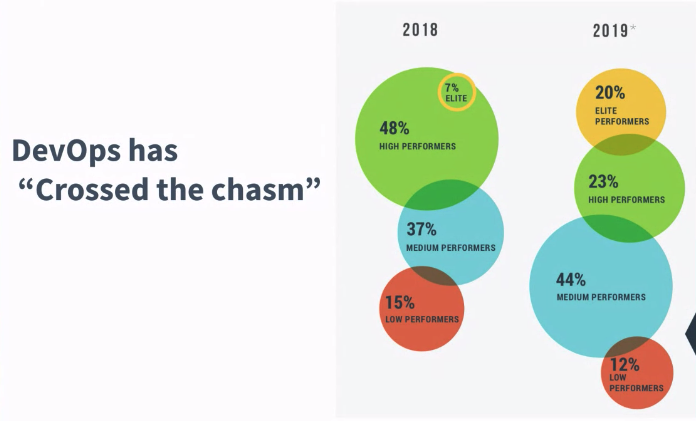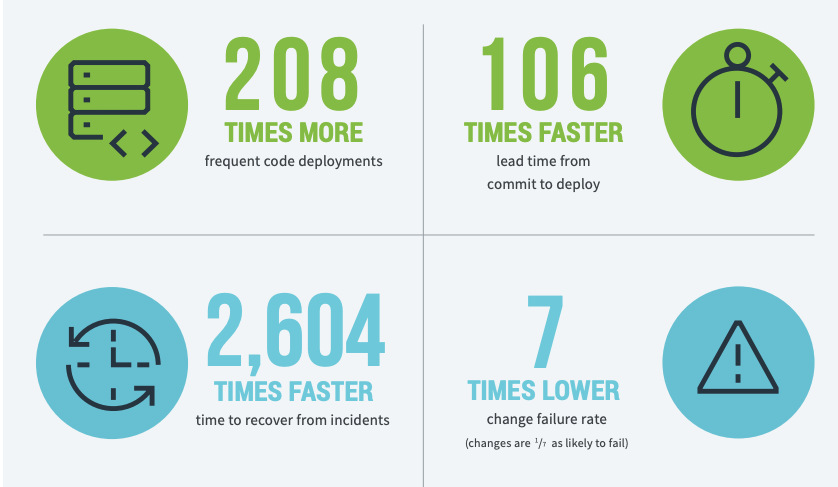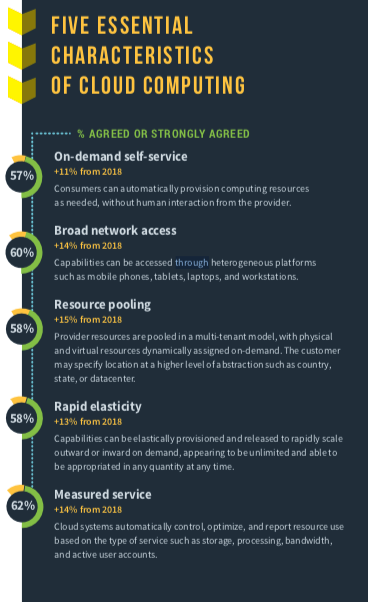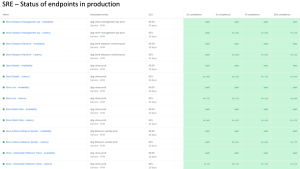Sign up now for our free webinar—2019 Accelerate State of DevOps—on Thursday, September 5 at 11:00am PST (2:00pm EST). Join us as we discuss this year's report directly with one of its co-authors, Dr. Nicole Forsgren!
"DevOps has crossed the chasm.”
That could be the defining insight from the just-released 2019 Accelerate State of DevOps report, produced by DevOps Research & Assessment (DORA), now part of Google Cloud. It’s a reference to one of the most striking and far-reaching conclusions in this year’s report: the growing number of software development teams leveraging DevOps to achieve elite performance levels with the quality of their code, and with their development and deployment practices.
Just a few years ago, many organizations still viewed DevOps more as a promising experiment than as a mainstream approach to software development. Today, however, as this year’s report shows, DevOps has secured its position as a proven and powerful set of practices and tools—giving teams the ability to make dramatic improvements in their performance and productivity.
DevOps is a driver for business success
Among other key points, this year’s report—of which New Relic is a sponsor—once again validates the assertion that DevOps tools and practices enable software teams to build increasingly reliable and efficient applications, while also deploying code even faster and more frequently (to make it happen, 57% of elite teams integrate with production monitoring and observability tools—more on that below). Even more important, it shows that these performance gains extend beyond the software development process to support overall business growth and profitability.
Download DORA’s free 2019 Accelerate State of DevOps report now!
The 2019 edition of the Accelerate State of DevOps report builds upon six years of research and data, based on input from more than 31,000 technology professionals worldwide. If you’re looking to understand and incorporate the full value of DevOps practices—and to pinpoint the tools and practices driving that value—then DORA’s research is absolutely essential. You’ll definitely want to read the entire report—created by DORA’s high-profile team led by Dr. Nicole Forsgren, Jez Humble, and Gene Kim—but we’ll focus on four key findings that can shape your own DevOps strategies, along with suggestions on how to put this knowledge to work in your own organization.
Key finding: many more organizations are becoming ‘elite’ DevOps performers
DORA’s research spotlights two critical questions: What traits separate high-performing software teams from their less-successful counterparts? And what role does DevOps play in elevating a team’s performance? This year’s research uncovered a striking trend: the number of organizations that DORA characterizes as “elite” performers nearly tripled, growing from just 7% of all respondents last year to 20% today.

The numbers show that many of these elite teams didn’t simply elevate their performance; they boosted it into the stratosphere. Compared to teams in the low-performing group, these elite software teams:
- Execute 208 times as many code deployments
- Maintain lead times, from commit to deploy, that are 106 times faster
- Report change failure rates that are 7 times lower
- Recover from change failures 2,604 times faster
As important as these advantages are, here’s an even more impressive metric: elite performers are twice as likely as low-performing teams to meet or exceed their organizational performance goals.

Our take: DevOps is for everyone
The growth in Elite Performers indicates that the DevOps formula for success is practical and repeatable. At New Relic, we’ve learned from our customers and our own internal experience that both large and small organizations can work towards smaller, more frequent releases with fast feedback loops.
Yes, DevOps transformation requires investments in an organization’s code pipeline, testing, instrumentation and monitoring, and other capabilities. Primarily, though DevOps is a mindset: an agile, assess-and-improve view that supports continuous improvement.
Action item: assess, then improve
Where should your teams begin their own performance improvement journeys? A good first step would be to review DORA’s Key Metrics and discover how your team’s performance stacks up against industry baselines for:
- Lead time
- Deployment frequency
- Change fail rates
- Time to restore following a failure
- System availability
From there, DORA’s Research Models offer a detailed and completely transparent starting point for understanding—and emulating—the habits of today’s highly successful software teams.
Key finding: the cloud drives DevOps success
Cloud computing gives DevOps teams a massively scalable, endlessly versatile, and highly cost-effective platform for building software as well as for deploying and running it.
What this year’s report reveals, however, is that many development teams aren’t as fully invested in the cloud as they think they are. By relying too much on “lift-and-shift” cloud migrations and failing to take advantage of key cloud capabilities, these teams are making it harder for themselves to achieve elite performance.
DORA found that 80% of respondents host their primary application or service on a cloud platform. Yet just 29% of respondents have implemented all of the National Institute of Standards and Technology’s Five Essential Characteristics of Cloud Computing—a critical standard for assessing the value of the cloud within a DevOps framework. Notably, elite performers were 24 times more likely to have adopted all five compared to teams in the low-performing group.

Teams that understand and fully leverage cloud services can gain a huge performance advantage over teams that don’t. In fact, taking full advantage of cloud services can be a difference maker in becoming an elite-performing organization and achieving game-changing improvements in speed, responsiveness, scalability, and customer satisfaction.
Our take: DevOps success depends on fully leveraging cloud services
Teams that fully embrace the cloud are in a much better position to achieve elite performance. A truly cloud-native approach is essential to support a faster, more responsive, and more agile development process. At the same time, many cloud capabilities deliver their full potential only when teams also embrace DevOps cultural and organizational practices, including tools and processes designed and optimized for cloud environments.
Consider a useful example: the fact that teams are using more multi-cloud and hybrid cloud solutions than ever before. Some teams likely don’t care where they host workloads; others may not have a choice or even full visibility into the composition of their cloud environments. Yet multi-cloud and hybrid cloud hosting can have a major impact on a team’s ability to monitor the health and performance of their applications, and to troubleshoot and resolve issues quickly.
Don’t miss: Watch how GE Digital uses monitoring to run modern software at scale
Action items: find your place in the cloud—and plan to improve it
First, review NIST’s Five Essential Characteristics of Cloud Computing mentioned above, and establish a baseline for your team’s current approach to using cloud services. From there, you can work to maximize the cloud’s value and impact during your DevOps journey. Of course, you also need to choose supporting tools and processes optimized for cloud environments.
Key finding: elite teams practice lightweight change processes
DevOps best practices endorse the use of lightweight processes for making code updates. DevOps emphasizes speed and flexibility—for example, using tactics such as automated testing and peer review to prevent bottlenecks and cut red tape. While some conservative project management and ops teams charged with managing risk still cling to heavyweight, waterfall-style development and deployment processes—for example, routing all code reviews through a Change Advisory Board (CAB)—this year’s report makes it clear that’s a bad idea: Organizations using heavyweight processes are 2.6 times more likely to be low performers. And while it may seem counter-intuitive, previous DORA research has already tied heavyweight code-review tactics to higher—not lower—change failure rates.
Our take: automation and instrumentation enable healthy change processes
We get it: Keeping a tight grip on software deployment processes can feel like the best way to keep bad code out of production systems. But consider what actually happens when teams rely on waterfall development and top-down reviews: bottlenecks, delays, and backups—all of which lead to bigger, less frequent, and higher-risk releases that contribute to higher change failure rates.
Action item: automate, instrument, monitor
Push your efforts to automate, instrument, and monitor your code pipeline onto the front burner. You’ll give teams better visibility into errors earlier in the development process; enable fast-feedback loops; and give lightweight change practices a chance to speed deployments and improve quality.
At the same time, insist upon a change process that is clear, thoroughly documented, and constantly communicated with the team: organizations with a clear change process were 1.8 times more likely to be elite performers.
Key finding: elite teams 'automate everything'
Continuous delivery (CD) represents a set of technical practices for delivering and deploying software that enable lower-cost and lower-risk releases—while also keeping releases in step with an organization’s business and customer experience goals.
Successful CD means, among other things, that teams can deploy changes on demand to production; that feedback on deployment quality is available immediately; and that teams can move rapidly to act upon that feedback and improve the next deploy cycle. This makes CD a bellwether capability for elite-performing software teams and, more broadly, for success with DevOps.
The 2019 Accelerate State of DevOps report reveals that elite teams set themselves up for success with CD by investing in a wide range of supporting processes, practices, and tools:
- 92% employ automated build tools
- 87% use automated unit tests
- 57% extend this automation to acceptance tests
- 72% automate their deployments to test environments; 69% do the same for production deployments
- 69% integrate chatbots or Slack into their deployment process
- 57% integrate with production monitoring and observability tools
The report also points out that usability has a significant impact on a team’s ability to maximize the value of their chosen toolset: Engineers with easy-to-use tools are 1.5 times more likely to belong to elite-performing teams
Instrumentation and tooling choices also play an important role in initiatives at the organizational level—namely, those related to creating loosely coupled application architectures. This model, which also makes use of microservices architectures and code maintainability practices, reinforces team-level practices that promote agility, resilience, and productivity; and that decrease technical debt and risk. Monitoring tools optimized for distributed environments, for example, can have a major impact on how engineering teams spend their time and how much value they create.
Our take: automation makes you nimble
The differences in tool adoption between elite and low-performing teams is striking: just 57% of low performers use automated unit tests, for example, and a mere 17% automate deployments to production. Second, the findings dispel the notion that teams can find silver-bullet solutions to their performance challenges; of the nine tools studied in this year’s report, seven were used by a majority of the elite-performing teams surveyed.
Don't miss: DevOps Without Measurement Is a Fail
Action item: treat automation as essential—not extravagance
Automation—with its ability to eliminate manual toil and to accelerate processes—may be the most practical investment DevOps teams can make on the journey to elite performance. Explore best-of breed-testing, automation, instrumentation and monitoring tools and platforms. And carve out time up front to eliminate manual toil so your team members can work more strategically over the long haul.
DevOps: the essential ingredient for elite performance
Roll it all together and it’s clear that real DevOps success isn’t about incremental gains or spinning the data. The 2019 Accelerate State of DevOps report reinforces DORA’s long-time message: DevOps tools and practices may not guarantee elite performance from software teams and organizations, but it’s also nearly impossible to imagine a software team achieving elite performance without a whole-hearted commitment to DevOps.
Les opinions exprimées sur ce blog sont celles de l'auteur et ne reflètent pas nécessairement celles de New Relic. Toutes les solutions proposées par l'auteur sont spécifiques à l'environnement et ne font pas partie des solutions commerciales ou du support proposés par New Relic. Veuillez nous rejoindre exclusivement sur l'Explorers Hub (discuss.newrelic.com) pour toute question et assistance concernant cet article de blog. Ce blog peut contenir des liens vers du contenu de sites tiers. En fournissant de tels liens, New Relic n'adopte, ne garantit, n'approuve ou n'approuve pas les informations, vues ou produits disponibles sur ces sites.



